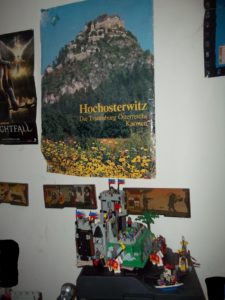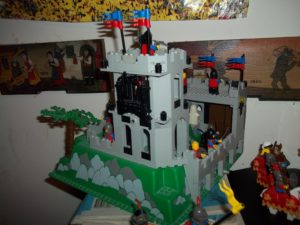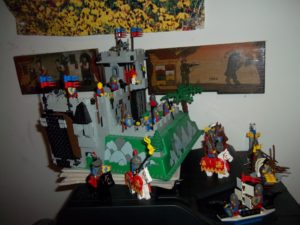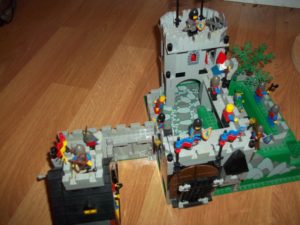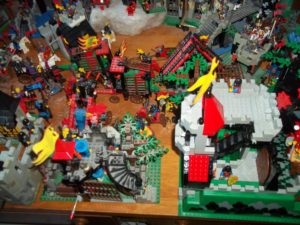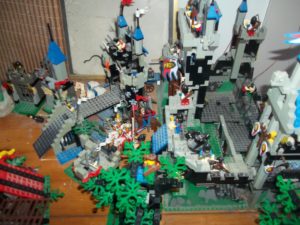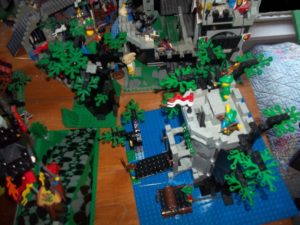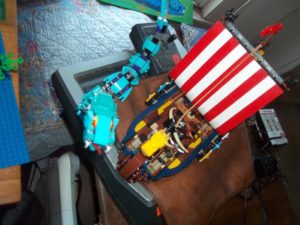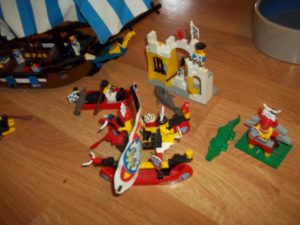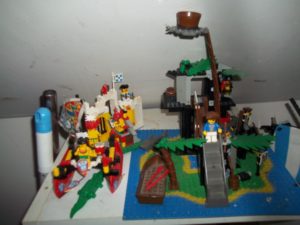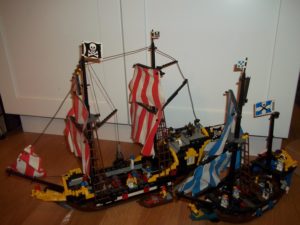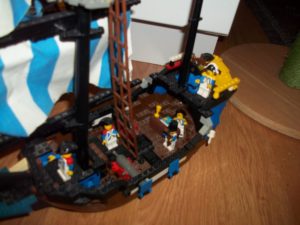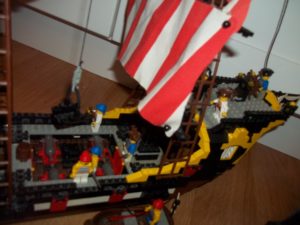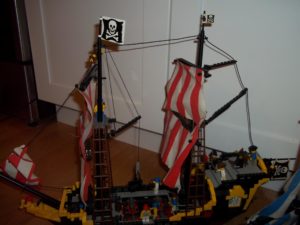Uh, yeah, it’s been too long. I haven’t been playing retro games much, honestly, other than Starcraft: Brood War, by far the best game ever made, which I got back into last week. I should write something about that game sometime, though given how terrible I am at it it wouldn’t be the most insightful.
I have written this, though. It’s an article about the worst game I own for each console I have, kind of the opposite of my ‘favorite games’ lists. However, I didn’t go back and play all of these games before writing this, so a lot of this is based on my memories of playing these games years ago and the score I’ve given them. Sorry about that. I hope that at least some of the list is interesting despite that. I know that my tastes do not always align with that which is popular, which is fine with me. Everybody is different.
The Worst Game I Own For Each Platform I Have
3DO – Shadow: War of Succession. This absolutely terrible barely playable disaster is maybe the worst game I own. This is a fighting game and it’s as bad as games can be to the point where it’s honestly surprising that it actually got published. Shadow is a Mortal Kombat clone, which was popular at the time, but it has the absolute worst controls, moves, and gameplay of any MK knockoff I have ever seen, and it’s not close.
Apple II – I don’t have any bad Apple II games but uh… Fight Night, because I dislike the genre, I guess. It’s a boxing game and probably a good one given that it’s well thought of, but I’m just not interested in the genre at all.
Apple II GS – Another system I don’t have any bad games for. The weakest is The Hunt for Red October. It’s average.
Atari 2600, 2600 – Freeway. This is a boring Frogger knockoff where you can’t move left or right, only forward or back. Lame. This awful game is one of Activision’s worst ever. The idea was to make a multiplayer-focused game but not being able to move left or right just makes this game miserably dull.
Atari 5200, 5200 – I don’t have any bad 5200 games, but the least good one I’ve got is James Bond 007, which is below average. This side-scrolling vehicular action game tries to do interesting things, but fails at pretty much all of them. It’s a pretty big disappointment with confusing objectives and iffy-at-best controls and design.
Atari 7800, 7800 – RealSports Baseball. This is an awful baseball game, which is sad given that the 5200 game of the same name was pretty good. They are similar but in a lot of ways this one is a huge downgrade. The speech samples and more are gone from this one.
Atari Jaguar CD, JCD – Space Ace. This may be a classic, but I’ve always hated Dragon’s Lair, and this game seems even harder and worse than that one is. Sorry, I can’t stand this game at all, it’s awful.
Atari Jaguar, JAG – Kasumi Ninja wins here for me, easily. The insanely awful jumping — this is a fighting game where you cannot control your jump in the air like NES Castlevania or something — alone justifies giving this game in a very low F tier score. The rest of the game isn’t much better. This is the worst Jag game I have by a good margin. I’m honestly shocked that you don’t see the insanely weird jumping system this game uses mentioned more when people talk about this game because it’s probably the most unique, and worst, thing about the game.
Bandai WonderSwan Color, WSC – There are a lot of very boring anime RPGs and adventure games for this platform, so should I just call it a tie between most of those for worst WSC game? This platofrm’s library is one of the least interesting around, for me! But of the very few WSC games I’ve actually cared enough about to play, I guess One Piece Grand Battle: Swan Collosseum is the weakest. It’s a very mediocre, below average fighting game. NGPC fighting games absolutely crush this subpar effort with its bad controls and gameplay. This game isn’t an F-tier game but I don’t like playing it.
Bandai WonderSwan, WS – Rockman & Forte: Mirai Kara no Chousen Sha is the worst Wonderswan game I’ve played. I am sure there are worse Wonderswan games — some of those anime RPGs surely aren’t any good — but I haven’t played those games so I can’t rate them. This game is infamously mediocre, and indeed it is; it’s not a total failure, but it is a bad game with poor controls, level designs, and more. You really can tell that this game had little involvement from Capcom, which indeed it did not. Bandai got one of the developers of some of the Game Boy Megaman games to make this game, but this game is dramatically worse than any but the second of the GB Megamans. And as bad as it is at least MMII for GB controls well, so it’s better than this game by a good margin. Rockman & Forte for Wonderswan is as poor as its reputation suggests. Still, though, it’s a playable game that series fans (like me) probably should try anyway. Just expect it to be one of the worst Megaman games ever — it is.
Colecovision, CVIS – Facemaker is an okay little kids’ game, but it’s the worst “game” I have for Colecovision because it’s so, SO basic. You just make a silly face basically by selecting from premade upper, middle, and lower part options. If you do not count this as a game, and it really isn’t one, it’s edutainment, then Super Action Baseball probably gets the ‘honors’ here. That game is a well below average, forgettable game not worth playing at all today. The special 4 button controllers it needs really aren’t worth such a mediocre, multiplayer-only baseball game. Play RealSports Baseball for Atari 5200 instead, it’s much better.
Commodore 128 – There are C128 games? I have a 128, but like most people with one I don’t have any C128 games. The only releases from its lifetime were text adventures you can get on many other formats. Is this the worst library ever in a popular, well-selling machine? Probably.
Commodore 64 – There are a lot of bad C64 games, but I haven’t played most of them; I don’t use my C128 much. Of the few C64 games I have and have played, um… I don’t know. It’d be something average but not bad like Radar Ratrace, Speed / Bingo Math if you count that as a game, Keypunch Software’s Adventure Pak, or something like that… I need to play some actual bad C64 games I guess, there are lots of them… though probably fewer here than in Europe, they got a lot more C64 games than we did.
Commodore VIC-20 – As with the C64, the worst I’ve played for this system is something slightly below average. I’m going with The Sky is Falling, a mediocre title for sure but not awful.
Dreamcast, DC – Rippin’ Riders Snowboarding wins here by a wide margin. This is a game that, objectively, is probably merely below average, but subjectively I absolutely hate. This is one of the least pleasant to play games I’ve ever played, it’s absolutely terrible. Perhaps the worst thing about the game is the announcer that constantly insults you, but the course designs and gameplay are barely any better. This game is from the CoolBoarders (PS1) developers, and I don’t think they ever figured out what snowboarding is, their games aren’t anything like it at all.
Game Boy Advance, GBA – Cruis’n Velocity is a quite terrible early polygonal 3d racer for the system. It’s nothing like past Cruis’n games and is pretty terrible in every way.
Game Boy Color, GBC – M&M’s Mini Madness is my pick here. How this platformer is so awful I don’t know, isn’t that an easy thing to do a tolerably okay job at? But this is not tolerably okay at all, it’s terrible.
Game Boy, GB – While there are surely worse GB games, my pick here is somewhat based on nostalgia. The worst game I bought for Game Boy in the ’90s was Toy Story, and that is still my choice for worst Game Boy game. Objecively are there worse games, surely. But for me there aren’t. With an excruciatingly slow framerate, awful controls, and confusing objectives, this game is terrible. Some people have fond memories for this title, particularly on console, but I’m sorry I have nothing but bad memories of this awful disaster of a game.
Game Gear, GG – If you count it, and you shouldn’t because it isn’t a game, House of Tarot wins this easily. This title is a tarot card reading title only released in Japan. Yeah, it’s a horoscope program. In Japanese, on Game Gear. You don’t get much worse. If you want an actual game though, it’s close but maybe I’ll go with World Series Baseball? It’s just such a terrible baseball game, the fielder movement is ridiculous — the first, second, and third basemen are glued to their bases, while you move everyone else together. What. I also need to mention Taz-Mania though, the game is just about as bad and has what is almost certainly the worst soundtrack of any title released in the US on any platform.
Gamecube, GC – Genre fans may get something out of it, but for me it’s an easy pick here: Whirl Tour. This skateboarding game does basically nothing to teach you how to play. YOu already know how to play Tony Hawk, right? You’d better before playing this game. This game is pretty bad all around on top of that too, so no, I don’t know how to play and don’t want to learn. This is a learning curve not worth attempting.
Mattel Intellivision, INTV – Sharp Shot is a bad minigame collection consisting of three very basic games. It’s aimed to be for young children, but even they will probably be bored in ten minutes. Even so, this game isn’t utterly dire; it’s merely bad, not a total failure. You might be mildly entertained during some of those ten minutes.
NEC PC-FX, PCFX – The video quality may be great, but as a game I hate Battle Heat about as much as you can dislike something. The ‘FMV fighting game’ concept does not in any way work, as you see with games like this or Supreme Warrior. What you end up with is an extremely frustrating game that requires extensive memorization, as the only way to not lose is to know exactly what move to use at each moment. The video might be nice but the gameplay is abysmal. But hey, at least it’s a game, unlike most of the visual novel-focused titles on this disappointing console… I may love books, but visual novels have never interested me at all.
Neo Geo Pocket & NGP Color – Almost all of the NGP and NGPC games that I have are good, but the NGPC version of Pac-Man is sadly disappointing. The core of this arcade classic is here, but either you play with unpleasantly tiny graphics or the game zooms in so you can’t see where the ghosts are. This is an unsolvable issue of the screen resolution of a ’90s handheld, but it is an issue that kind of ruins Pac-Man.
NES – My pick for worst NES game that I own is the quite subpar beat ’em up/action game Phantom Fighter. Some people like this game. That’s fine, I can see why someone would, but I am not one of those people. This game has awful controls and is incredibly repetitive and basic! The game is just so boring, I don’t have any fun at all and don’t find playing it rewarding. I know there are even worse NES games out there than this, infamous titles I mostly do not own, but this one should be in the running for being on the list of bad NES games at least. I have to mention another game too, and it’s one everyone agrees is bad. Transformers: Mystery of Comvoy for Famicom is every bit as bad or worse than Phantom Fighter, and it’s a lot more infamous too. This game deserves every bit of its terrible reputation. Controls, gameplay, level design, enemies, the off-the-charts difficulty… everything here is awful. This is kind of the amusing kind of bad, though, the kind of bad game you walk away from thinking ‘yeah, playing bad games is fun’. And in a weird way it can be.
New 3DS, N3DS – The New 3DS doesn’t have any retail exclusives, but there are digital exclusives. A lot of those are pretty mediocre indie titles. On my list though, I’ve got the lowest scores by two* games which I gave failing ratings to: Stack ’em High and 3D Retro Dungeon Puzzle Challenge. The latter is a little mini first person dungeon game, which may sound good but it isn’t. The game has almost no content, and all levels except for the last are exceptionally easy. The last of the dozen or so stages does present a challenge, but when it’s the only one that does at all and teh actual gameplay is extremely basic FPS-ish stuff there’s no reason to actually keep trying to beat it.
As for Stack ’em High, it’s a competently made but very annoying dexterity puzzle style game. Various objects drop from the sky and you need to try to stack them up without too many falling off of the little platforms they are falling onto. It’s a solid idea that some games do well, but I just thought that this one is way too frustrating for its own good. You will lose, over and over, and it won’t feel fair; no matter how good your stacking is, they’ll fall off every time. Avoid this poorly executed failure.
Nintendo 3DS, 3DS – The worst game I’ve got for the 3DS is actually a physical cart release, and not one of the hundreds of digital 3DS games I reviewed in my 3DS digital download game opinion summaries series: Dream Trigger 3D. This game is an absolutely awful rail shooter-ish game and the neat 3d effect in no way saves it. This is a really really bad game, avoid it. As for downloadable games, the worst two I played are Space Defender – Battle Infinity and Bricks Pinball VI, which are both F-tier games mostly for bad controls. Both have solid classic arcade style game concepts, but with controls as poor as they have you won’t want to play them.
Nintendo 64, N64 – Sadly, Elmo’s Number Journey and Elmo’s Letter Adventure are probably the worst games on the N64. It’s not that I’mn too old for kids’ educational games; I can enjoy those if they’re good. The problem here is that these titles are exceptionally short, with maybe a half hour of content each, and are barely educational. Literally all you do in each game is walk around and touch dozens of a specified letter or number. The game says ‘touch 20 R’s!’ so in that level you touch all the R’s, avoiding other letters. And that’s the whole game. I know this is for young players, but seriously, this is far too basic a concept to work. There’s no math here, no reading beyond letter recognition, nothing but literally just “hit button by specified object for a few minutes then win”. It’s really bad.
If you don’t want to count those two as games, next worst on my list is War Gods. I guess some people don’t totally hate thgis game, but I do. War Gods was Midway’s first attempt at a 3d fighting game and I’d say that it’s probably the worst Midway game I have ever played. It’s kind of humorously incompetent, but absolutely nothing about it, not the poor graphics, lame characters, or anything, makes me ever want to play it, and nor should you. Sure, the game functions so it’s not as bad as say Shadow: War of Succession for 3DO, but the fun factor is about as low as it gets.
Nintendo DS, DS – L.O.L. and Legend of Kay are at the bottom of my list for the DS. The former is barely really a game, it is a messaging chat program thing, except not online of course. This “game” is local multiplayer only, it has no single player. With this cart you can text chat with other people nearby on your DS, if they also have this thing. Except… the DS has a built-in app for doing that! This is just that except with a few more features and a few awful multiplayer-only minigames, but given that text chat between DSes sounds like about the most useless thing ever to anyone not living in 2004, this cart isn’t worth the plastic it is made with. Avoid at all costs.
As for Legend of Kay, for those who remember the pretty decent console game, this Nintendo DS title is entirely different. The developers of the handheld Legend of Kay game made the strange decision to make this handheld adaptation of a third person action-adventure game into an overhead stealth game where you cannot attack enemies, at all, ever. Like, the perspective change makes sense. The genre change, though… why? I don’t get it. This is NOT a good stealth game, either, it’s probably the least fun one I have ever played! I have no idea why this game was made the way it is, but it’s unfortunate that it was. If it was actually a decent stealth game maybe it could have worked, but while it’s been some time since I played Legend of Kay I sure remember that not being the case.
Nintendo DSi, DSi – I do not have any of the couple of retail Nintendo DS games, but for its digital library, of the relatively few I have played Wizard Defenders disappointed me the most. This game is certainly not the worst DSi game, I’m sure there are some truly terrible little games released digitally for the platform. It’s just the worst of the relative handful I have actually played. This game is a blockdropping-style puzzle game with wizards of various colors as the ‘blocks’. It has some good ideas and almost could have been good, but ultimately it just isn’t, at all. If you like being frustrated and annoyed at unfair, random puzzle games which will make you lose without seeming to make any mistakes, go ahead and try Wizard Defenders. I do not find that my idea of fun so this failure is the worst DSi game I’ve played. That the concept seems interesting but the game isn’t that great surely is part of why the score ends up being that low.
Nintendo Switch, NS – The worst Nintendo Switch game that I have actually played is probably a digital-only release, Hover Racer. I like futuristic racing games a lot, but this exceptionally low-budget affair is so simple and boring that it barely even feels like a real game. The game has a decent if very simple look, but the gameplay is about as simple as you will find as you drive along the games’ narrow, simplistic floating roads, trying to finish in first. Slowly drive, that is, because there isn’t much sense of speed here to be found. It’s obvious that this was a game probably made by one or two people, and that’s fine, but it’s just too bland and basic to really be worth much playtime, unfortunately.
For physical releases, the easy pick is the one Pokemon game I have, Brilliant Diamond. I gave this game a try for some reason but I’m not sure why I did, it did not change my opinion of the Pokemon games one bit. I do keep thinking of trying the new ones since they change the classic formula, but the older ones like this thing? As with all Pokemon games before, what, Black or something the story is so simplistic that it barely even deserves to be called a story, and the gameplay is the same ‘do you know the rock-paper-scissors-ish unit counters’ turnbased RPG game that Pokemon has always been and I have never had even the slightest interest in trying to learn. If I hate any Switch game this one is it, it’s just so unbelievably boring! I know this is probably the most popular franchise of the last 30 years but sorry, that won’t make me like them any more than I ever have. With that said though, the Pokemon Ranger games on the DS were pretty good, I liked that spinoff, and there are some good Pokemon puzzle games. I don’t hate everything Pokemon just because it has the franchise on it. I just don’t like the gameplay much, don’t care about “catching them all” in any way, don’t find “collect all the creatures” an interesting gameplay hook, and find the barely-extant plot a zero out of anything as far as story goes.
Nokia N-Gage, NNG – It’s a tough one with this platform, on this thing just about everything is terrible with its awful phone screen and ludicrous button layout! But of the whole five N-Gate carts that I have, the worst is Sonic N. It’s a port of the well below average (I would say) GBA game Sonic Advance, except it’s significantly worse on the N-Gage since with its vertically-oriented screen you can barely see anything in front of you. If you enjoy fast-paced platforming where you can’t see anything in front of you, try this game. Otherwise stay far away.
Odyssey 2, O2 – I like the Odyssey 2, it’s a weird but good old console. Of its library, though, I have Thunderball! scored the lowest. It’s a pinball game, which is fine, except the physics are extremely poor and the screen layout very simple. Most early pinball games are like this, but this is one of the weaker ones of them. The physics and layout are just too basic to hold my interest at all. Thunderball!’s sadly pretty bad.
PC (1981-1990) – I don’t actually own all that many retail PC games from the ’80s; we got our first PC in ’92. I played a lot of shareware and freeware games from the ’80s, but didn’t buy most of those so those aren’t on this list. There are a lot of ’80s PC games I don’t find interesting; I think computer games got a lot better in the ’90s. The problem is, I have never played most of those games enough to be able to rate them. So what’s the worst ’80s computer game? I don’t know. That freeware racing game motorman.com sure wasn’t any good; it’s one of those ‘drive along and jump over buses on your motorcycle’ games, but… you don’t need ot jump over the buses. You can just land on them and will pass right through. All you need to do is just learn how to land and the game is over in minutes. As for retail games, though, looking at my list, the lowest score for an ’80s game is a game that is actually pretty good if you like the genre, the highly regarded RPG classic Dragon Wars. I scored it relatively low because I got it in a collection in the late ’90s, and didn’t like that you need to draw a map on paper instead of the game including a map in the game (this was sadly common in ’80s first person RPGs) and that you need to go read paragraphs in the manual sometimes in order to save space in the game or something.
PC (1991-2000) – My pick for this, the best decade of PC gaming by far, is Beast Wars: Transformers. This PC/PS1 third person action game is one I first played a demo of back when it first released, and I thought that demo was was probably the worst retail game I’d ever played. That first impression stuck, which is why it’s scored the lowest here. I’m sure some people have fond memories of this title, but I think it’s one of the worst games I’ve ever played. The graphics are extremely bland, gameplay is exceptionally basic ‘walk around and shoot everything with your lame laser weapon and stuff’, voice samples really annoying — I can still remember some of them, and not in a good way! Yeah, this game’s just awful, awful junk. The game was obviously designed for the PS1 first and this PC version is an afterthought, the bad graphics show that pretty clearly, but it’s the core gameplay that is the main reason it’s on my list here. The runners-up, which are only barely worse, include VR Sports Powerboat Racing (I know, some people like this game. I stand by my opinion that is is atrocious.) and Test Drive Off-Road, the worst retail PC game I actually owned in the ’90s. TDOR is another PS1-first game that’s an unfun disaster of zero-fun design.
PC (2001-2009) – For this decade of the PC’s decline and fall, what choice is better than a game based on the Star Wars universe’s decline and fall to the Sith, Star Wars: The Clone Wars — Republic Heroes? This game tries to be kind of like the TT Games Lego games, except without the Lego license. The results sadly is a significantly worse game than those decent-but-unspectacular beat ’em up-styled games. And yes, I’m sorry, but I’m not a big fan of the TT Lego games. They’re okay I guess but I have never found them very interesting. Anyway, this one’s worse. Republic Heroes is a boring, by-the-numbers beat ’em up-ish action game. You play as several of the characters from the show, including Anakin and Ahsoka, and walk along defeating enemies and sometimes jumping between platforms. That sounds fine, but I thought the game was about the most boring one of these I’ve played in decades, which is the main reason I am mentioning it here. Additionally, this game does NOT have drop-in or drop-out multiplayer, and you can’t choose your character either. Instead, at the start player 1 is Anakin and player 2 is Ahsoka. Want to have things the other way around, or play as one player as someone else? Sorry, you can’t. It’s pretty lame. This game is awful and one of the worst retail PC games I’ve played.
PC (2010-2020) – For physical games, the lowest score I see on my list is a game I gave a solid above average score to, TES V: Skyrim. I just don’t have many physical PC games from after the ’00s, they died out sadly quickly in favor of digital. Bethesda games aren’t my thing but they’re fine, Skyrim included. For digital games, though, I’ve got plenty of actual bad game options. The worst on my list is one that a lot of people love but I absolutely hated, as I said in my summary about the game on the site: Terraria. Why do people love this, again? It’s the worst of Minecraft and side-scrolling platformers smushed into one. I have absolutely no interest in Minecraft since I hate crafting and don’t like its visual look or aimless, objective-free design, and this game is very much that but maybe even worse, with boring generic sprite graphics and absolutely nothing to make me interested in playing it at all ever. I find this honestly one of the worst I’ve ever played. It well deserves its place on this list.
PC (2021-present) – Honestly, I don’t have enough PC games released in 2021 or later to be able to say anything here. Looking at my list… uh, sorry, I haven’t played enough recent PC games to say much. And when I do play PC games it’s mostly good ones. The few 2021-or-newer PC games on my list have high scores.
Philips CD-i, CDI – The worst CD-i game I’ve played is simple: Dark Castle. Yes, it’s every bit as unplayably awful as you probably have heard. This games’ controls make some shreds of sense on a computer with keyboard and mouse, which it was originally designed for, but on a console where you either use a d-pad, mouse (but NOT keyboard), or awful remote wand thing, it doesn’t work at all. You need to somehow move and aim your arm at the same time, and you really can’t without multiple sticks or keyboard and mouse, and this console doesn’t have that. The game was not adjusted much to account for this and the result is that an already not very good computer game became one of the most infamously terrible console games of its era for both Genesis and CD-i. Just try to control this game… it won’t go well. The graphics are somewhat bland and gameplay not all that great as you slowly move around the screen and try and try to not die quite as quickly this time, but it’s those controls that really make this game terrible.
PlayStation 2, PS2 – If we’re going purely by personal bias and not by actual game quality, my pick here is Gauntlet: Seven Sorrows. This game is an F-tier game, but it’s certainly not the worst game ever objectively; it’s just yet another bland, easy, and mediocre God of War knockoff. I mostly hate this game for being a Gauntlet game, a game in one of my favorite classic franchises, that plays so little like Gauntlet and instead takes its main inspiration from a game I strongly dislike, God of War. Ugh. It’s the wrost for being a boringly easy and bland game that plays nothing like how it should: Gauntlet.
But if you ignore that because it’s not actually the worst, then my pick is Space Channel 5: Special Edition. I know, this is another popular game, but I’m sorry, I found it completely impossible. In this music game you somehow need to know which button to push at which time even though the game doesn’t tell you what to actually do. It makes absolutely no sense and while people have attempted to explain this game to me before, I’m sorry but it’s one of the worst I’ve ever played. Shouldn’t the bare minimum for a music game be, like, TELLING YOU WHAT TO PRESS AND WHEN? This game doesn’t do that, then punishes you for failing to have correctly guessed what buttons it didn’t tell you when to press. It’s just absurd design. No.
If you want something else, that most people would agree is bad, the next worst PS2 game I have is Legion: The Legend of Excalibur. I really don’t remember much about this game other than it’s yet another generic, forgettable third person action/beat ’em up game, but worse than almost all of them. Todd McFarlane’s Evil Prophecy is a similarly awful beat ’em up for PS2 as well.
PlayStation 3, PS3 – For PS3, the worst game I’ve played is Twisted Metal (2012). The gameplay is mediocre and forgettably average-at-best car combat — I have never enjoyed playing Twisted Metal games at all and this one did not change my mind about that at all, I’ve always thought they are poor to bad — but the main reason it’s on this list is for the game’s theming. This game is exceptionally obnoxiously hateful. The main character, the iconic clown guy face of the franchise, is an evil clown who is a serial killer. Does he suffer for his crimes? No, of course not. The other characters are no better. Twisted Metal is all about being edgy and blowing through the borders of good taste, and while I’m okay with dark themes where they are appropriate, how is a mediocre car combat game an acceptable place to have such excessively over-the-top hateful themes? It’s not okay. I don’t want to actually act out, as the protagonist, that kind of story. I will never play this game again.
PlayStation 4, PS4 – Of the relatively few PS4 games I’ve played, the worst probably is the below average digital-only title The Five Covens. It’s a not very good 3d platformer with some fun wizard theming but bad controls and subpar gameplay and stages. Skip it. For disc games I haven’t played many games for the PS4 and haven’t played any bad ones. I’ve got Bloodborne scored lowest of them, but that’s only because I don’t enjoy Dark Souls games much. It’s clearly well made. If I had to play a Playstation Dark Souls game though I’d rather play Demon’s Souls… I do like medieval settings better than pseudo-Victorian ones.
PlayStation Portable, PSP – For the PSP, the lowest-rated games I’ve played are Rush and Generation of Chaos. The former is another one of those “I know it’s not ACTUALLY terrible, I just hate it for being not at all what I wanted from one of my favorite franchises” titles. Rush is a port of LA Rush for PS2/Xbox, a generic and forgettable tuner racing game from the tune racing boom that uses the name of the exceptional San Francisco Rush racing game series, my overall favorite racing game series ever. And then they made THIS, a mediocre tuner game with barely any cool big jumps and average tuner-car driving. It’s boring and below average for sure, but terrible? Probably not, unless you hate it for misusing its license as I do.
As for the other game, Generation of Chaos is the first game of a franchise of confusing and hard to get grips with strategy games from Neverland. That studio made some good games and some bad ones, but after trying to figure out this game I eventually decided that it wasn’t me, it was the game. It plays a bit like the Saturn classic Dragonforce, just worse, as you control units that act as groups of soldiers in little animated battles. This game feels low budget and has a lot of issues, though the confusing design is first among them. The game is very poorly explained and neither the game itself or its manual are of much use. Even if you figure it out, though, I somehow doubt that it’d be worth it. There are probably worse PSP games out there than this one but it’s certainly not a GOOD one.
I have to mention third place; it’s another somewhat popular game I can’t stand, the PS1 “classic” MediEvil. Why PS1 fans tried to convince themselves that this awful game was anything other than terrible I’ve never understood but I do not share that opinion. Gameplay, graphics, controls, design, it’s all bad on either PS1 or PSP.
PlayStation Vita, PSV – Of the PSV games I’ve played, two have failing grades: ModNation Racers: Road Trip and Tearaway. The former is a generic and mediocre racing game held back by issues such as excessively long load times and extremely generic Mario Kart-but-worse gameplay. The latter is the bigger disappointment, as the platformer Tearaway had some hype but I didn’t find it fun at all. This game got good reviews… why? I’m sorry, but it’s awful. It has your usual terrible Media Molecule controls and awful physics that ruin all of their games, but this one is worse than most of their games as it doesn’t even have the “but you can make your own levels!” hook of their other games… skip. Do not buy. I wish Media Molecule understood how to make a platformer that feels good to play control-wise, but they do not. At all.
PlayStation, PSX, PS1 – I’ve got a lot of options for this console, there are quite a few utterly abysmal games for this bad game-laden console. The worst on my list, though, is Largo Winch. It’s one of the least fun stealth games ever made. It’s so bad that it just barely edges out a bunch of other atrocious games, including Die Hard Trilogy (this game is one of the top games on my ‘why do people say this utterly atrocious disaster of a game is decent?’ list), the awful 3d platformer Psybadek with its horrible floaty controls, Robotron X and its far too close in camera to be at all playable, and RushDown, the utterly dull and boring extreme sports racing game that manages to be even worse than one of my most disliked series of that era, the 1/2/3Xtreme trilogy. (Where’s MediEvil? I don’t have the first one for PS1, but even if I did it’s nowhere near as abysmal as these games are. That game gets a higher F score than these by several points.)
Saturn, SS – For the Saturn, the pick is easy: TNN Motorsports Hardcore 4×4. This multiplatform racing game is a mediocre effort on both PS1 and Saturn, but the Saturn version is dramatically worse thanks to one of the least playable framerates I’ve seen in a game this side of a polygonal 3d game on the Super Nintendo. Heh… sorry Race Drivin’ for SNES. This is about as slow as that or worse, and is much less playable. This is another one of those games where I’m confused about how it actually released in this state. I know that with time you can get used to low framerates, but this is SO SO low that I have trouble imagining that anyone actually could enjoy playing this game. Even if you could its ‘drive 4-wheeler trucks down narrow canyons in boring races’ design isn’t any good, but the framerate takes it from merely poor to all-time terrible.
The top honorable mention for me on Saturn is another all-time terrible game, the reviled fighting game Criticom. Criticom’s no match for Shadow: War of Succession for bad fighting games, nothing is, but short of that this game is one of the worst ever. Criticom is a legendarily terrible early 3d fighter with some of the worst design you’ll ever see. The developer would go on to make Dark Rift for N64, another one of my ‘why do people say this terrible game is okay?’ list titles. It’s slightly better than Criticom but not by much.
Sega Genesis, Gen – Mallet Legends Whac-A-Critter is an unlicensed Whack-A-Mole game for hte Genesis. The company actually released a little whack-a-mole controller for the game, which surely makes it a bit less horrendously unplayably terrible, but with controller this game is absolutely dire and I doubt that the special controller helps all that much. You press the d-pad in a direction with the button to hit the nine available spots. That’s fine, but the game is absurdly, brokenly hard far beyond any sanity. This game is unlicensed for very good reasons, did it get any play testing? Even when it’s not hard the concept is so basic that it’s not a very good home console game, but the broken difficulty finishes off any chance of it being decent.
Sega CD – If I had the Sega CD version Supreme Warrior would “win” here, but I only have the 32XCD version of that game so instead Midnight Raiders takes it. It’s a bad ‘move the sight around the screen and shoot the enemies’ FMV game. Memorize when to shoot where or die. Or quit and don’t play games like this, that would be a better idea. There are a lot of really awful FMV games on the Sega CD, including Midnight Raiders, Tomcat Alley, Night Trap (though this is another one I only have the 32XCD version of and not the Sega CD versions), and Double Switch. Yes, I do consider all four of those to be VERY VERY VERY bad games. I’ll say why for Night Trap in the 32X section, but its sequel Double Switch is basically the same thing but with a new setting. It’s just as awful as the first one.
32X (cartridge games) – Cosmic Carnage. This is a decent game which gets a passing grade for sure. It’s below average but is far from terrible, and has some pretty interesting ideas. This is a 2d fighting game and its neat concepts include being able to equip different armor types onto your characters and some cool scaling effects on some of your moves as your limbs spin around in 3d as you swing. It’s a decently amusing time, but the mechanics are poor so here it is on this list, undeservedly. The actual worst 32X games are the two FMV games below.
Sega CD 32X – Supreme Warrior easily wins here. This FMV fighting game may have very nice video quality in this 32XCD release, but unfortunately the gameplay is the same. This is a first person FMV fighting game, and you play by memorizing which move to use against each enemy in each specific video clip they play against you. If you don’t know the right move, you get hit. It’s a nearly impossibly hard game unless you spend a LOT of time memorizing video clip inputs, and I can’t possibly imagine that time being worthwhile in any way. This is seriously one of the worst games I’ve ever played.
Night Trap may be a highly memorable “classic”, and again this version has nice video qualiyt, but its core design is about going to empty rooms, memorizing exactly when to be in those rooms, and hitting the correct button at exactly the right time each time in order to defeat the enemies. Meanwhile, on other monitors videos play telling the story, but don’t try to watch them much! You’ll miss the enemies if you do. It makes no sense to make a game like this, and why some people (hopefully ironically?) claim to like it makes even less sense. It’s a really, really, REALLY bad game, one of the worst.
Sega Master System, SMS – This might be a popular pick, but … F-16 Fighting Falcon is definitely not very good. The graphics are basically the visuals of a SG-1000 game, and the gameplay is incredibly dated, and was pretty much from day one given the limited visuals. The actual loser for the SMS though is probably the Sports Pad controller, which is the worst, least responsive trackball that I have ever used.
Super Nintendo, SNES – This may be another controversial pick, but for me the adventure game Pac-Man 2: The New Adventures takes the crown here for worst SNES game I’ve played. In this game you control a cursor as you watch Pac-Man go around the screen and do stuff. You cannot control him, only interact with things on screen to make things happen that hopefully he will react to in the way you need to solve the current puzzle. It’s a concept, but it’s a bad concept because the little guy will rarely do what you want. If you could just control the character this would be a totally okay puzzle adventure game, but having to basically play this second or third person as you try to make him do the things you want without being able to control his actions at all is just so incredibly frustrating and obnoxious that I can’t stand this game at all. It’s awful.
Second place on the SNES is a very forgettably mediocre racing game, Kawasaki Caribbean Challenge. There are two Kawasaki racing games on SNES, and this is the bad one. It’s a bad top-down racer with extremely bland graphics and poor gameplay. I love top-down racing games when they’re good, but this is the opposite of that with boring tracks, graphics so poor you can barely tell this is the Super Nintendo, and gameplay very far from the better games in this subgenre. You’ll play one or two races then turn this game off forever.
TI-83+ Calculator – While the TI-83+ is a great graphing calculator, it’s a terrible games platform. I got one of these in high school for math and liked it for that, but for games? I know a lot of people like TI calculator games, but I never did. I actually got a PC-to-TI cable a few years ago to try more games than the handful I had on my TI-83+ originally — I only had, like, Snake, Drug Wars, and Tetris, I think — but… well, I couldn’t get most of them to work and the few I did were as terrible as expected. Who knew that a screen with an extremely slow refresh rate not designed for moving graphics, on a platform with no sound support, would have utterly unplayably awful action games? Huh, strange… :p
So yeah, I’m sure there are worse, but Flappy Bird for TI-83+ is an unplayable wreck of a game thanks to that refresh rate. How is this actually supposed to be playable? It’s not. I know “games running ON A CALCULATOR and I can play it in school during math class!” was part of the appeal, but… I’d rather have just paid attention in class and went to play some Game Boy later, you know? On that note it’s not like Tetris for TI83+ is very good either, it isn’t. The GB version is like a thousand times more playable.
TI-99/4A – This classic computer is one I like, for some reason. The lowest score I have for a game is Blackjack & Poker, a completely acceptable single player only card game collection. It scores low because I have zero interest in poker and this is a very bland old blackjack game which does nothing that a thousand newer blackjack games don’t do better, so there is no reason to ever play it. For other genres, probably the weakest is The Attack. It’s not an utterly awful game, but it is below average and boring. Of the TI99/4A overhead ship shooting games, and the system has a good number of them, this one is easily the worst — it’s got awful, ear-piercing audio and very slow and boring gameplay with minimal challenge. You just wait for the enemies to spawn from blocks, wait some more, wait a little longer, and then easily shoot them once they finally appear. Zzzz.
TurboGrafx-16, TG16 – Battle Royale wins it here. This game is a pretty bad wrestling game with weird controls and only one mode. You pick a wrestler, go into the match, and try to throw the other people out of the ring. The throw input’s awkwardly weird, read that manual if you want to get anywhere. This game has 4 player multiplayer, but after a match or two most people will never want to play this extremely slight, forgettable game again. There’s zero depth and even less gameplay of any note.
Next worst is another early TG16 game, Takin’ It To the Hoop. This basketball game is confusing, and honestly I never figured out how to play it well. This game tries to be somewhat realistic so it’s 5-on-5, but they really hadn’t figured out yet how to make basketball games fun, and this one sure isn’t. It also isn’t simple or intuitive, and learning how to defend, shoot, etc. is much harder than it should be. I don’t think this game is worth learning how to play. NBA Jam is the great classic basketball game, not this. This is also a lot worse than other simmish basketball games like Double Dribble (NES), as well, with more confusing and slower gameplay.
Turbo CD, TCD – For Turbo CD, the lowest score I have is for Bikkuriman Daijikai. This is barely a game, though — it’s a trivia game based on the Bikkuriman anime/manga franchise, in Japanese. I’m sure people who like that anime and can read Japanese might like this trivia game but I am neither of those things. Otherwise, Sailor Moon Collection is also almost equally awful. It’s a minigame collection with a handful of bad, extremely basic little minigames. There are a bunch of good Sailor Moon games out there, including beat ’em ups and an RPG for the SNES, but this one is one of the worst, unfortunately; this is basically one of those extremely basic minigame collections aimed at a young audience, and it won’t interest anyone else.
Virtual Boy, VB – While there are a few bad VB games, I do not own them. The “worst”, I guess, is Virtual Fishing, purely because I have absolutely no interest in fishing games. It seems like a very solid classic fishing game, but the subject matter’s a massive negative for me so here it is.
Wii – I have to mention Metroid Other M here for what its story does to Samus’s character. It’s a well deserved worst for that alone. Next worst is Billy the Wizard: Rocket Broomstick Racing, a PS2-port racing game with the worst motion controls I have ever had the displeasure of experiencing. I like good motion controls, and a lot of Wii games have good motion controls and benefit from them. This games’ are the exact opposite of that. It’s one of the most unplayable games I’ve ever played, and no, there isn’t a stick-based option; the controls are motion-only and are basically broken. Even beyond that this game is exceptionally low budget with really bad graphics and very basic environments, but it’s the controls that are the worst and most memorable thing about this game. Play it if you want to dislike motion controls even though when done well they’re great.
A few other games near the bottom of my list for Wii are Soulcalibur Legends (a sadly boring and bad beat ’em up in the Soul Calibur franchise with very few playable characters) and another music game some people love but I absolutely hate, Rhythm Heaven Fever. That’s another game I can’t play at all, I don’t think I have ever beaten a stage of that awful game. If you like it that’s nice for you. I do not and think of it as one of the worst I’ve played.
Wii U – This is another controversial one, but for me it’s no contest: the worst Wii U game I’ve played is easily Tekken Tag Tournament 2. I have always hated Tekken games, I think most of them are absolutely terrible to play with controls I strongly dislike, and this one is no exception. The PS1 games are probably the least bad Tekken games, but everything after that is just awful with few redeeming qualities. I’m sure many people like this series’ ‘each button is a limb’ control system, but I hate it. I got this game despite knowing I might dislike it because it was neat to see a Tekken game actually release on a Nintendo console, but unfortunately it did not change my mind one bit about this franchise. Quite the opposite, I think I might have hated this game even more than the other Tekken games… though I don’t know, I found all of them from 4 on quite awful. This is a game on my worst fighting games I’ve played list. (Tekkens 4, 5, and 6 are also F-grade games for me, but slightly less bad than this one. I haven’t played 7 or 8.)
Xbox – The worst Xbox game? It’s probably Kabuki Warriors, another game on the ‘awful fighting games’ list. Kabuki Warriors tries to be a cool MK-ish fighter, but it doesn’t work, at all. It’s a painfully bad game to play. Second worst is the racing game Pulse Racer. This game has a potentially interesting mechanic where there is a pulse meter, and if it goes too high your character will black out. Unfortunately, while a neat concept it doesn’t work well at all in practice. The tracks and gameplay aren’t very interesting either, dragging this game down into this very low F tier, but the pulse meter is the main thing here and it it’s like… “have too much fun and you’ll lose!”. Why would I want that?
Xbox 360, X360 – It’s easy, the worst X360 game I have is again Tekken Tag Tournament 2, followed by Terraria. I’ve mentioned those already for other platforms, though. The worst exclusive is probably Bomberman: Act Zero. The core gameplay is fine, but the aesthetic is just so comically wrong for Bomberman that it almost ruins the game. That isn’t the worst thing here, though, the game design is: you basically get only one life. Die and you start the game over. It’s ludicrously unfun nonsense. Play any other Bomberman game instead of this.
Xbox One, XONE – While I have played a fair number of games for this system, I haven’t played any really bad X1 games. There’s nothing I’ve played for X1 I’d give a failing grade to. The lowest scores I have are some slightly below average scores, for Sea of Thieves (I just don’t find it fun, it’s too aimless) and Killer Instinct [2014] (I’m awful at long combos and just cannot memorize them, which is why I’ve never liked KI games. This one sadly is no exception. It’s not the game, it’s me… but I definitely don’t like it.)
Xbox Series X, XSX – The worst game I’ve played for this system has to be Gears 5. Gears 5 isn’t terrible, but it is a bad game for sure in a bad franchise. I remember not liking the first Gears of War game at all, but hadn’t played any after that until this one. I was somewhat shocked at how similar Gears 5 is to the first one; it feels basically like the first one with only minimal changes other than better graphics and a few more moves and such. Hide behind waist-high walls, shoot, repeat. Fall asleep from boredom because of how dull this game is. So yeah, I still don’t find it fun at all, this is just as bad as the first Gears with minimal changes. I had to quit after an hour or two because of how tediously dull and unfun this game is. It’s clearly well made, but how much does that matter when a game is this disappointing? This game isn’t an F-tier game, but it is well below average. Given how successful this franchise is, obviously my tastes in games do not align well with what’s popular, heh…

